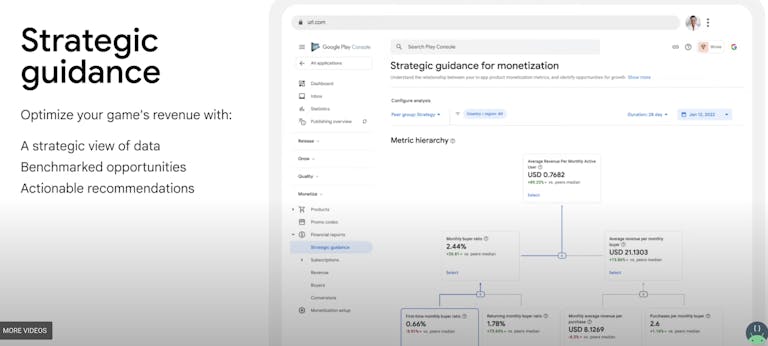
Google I/O 2023 公告:回顾
与 iOS 的 WWDC 类似,Google I/O 是 ASO 年度盛事,因为 Google 会分享即将为 Android 和 Google Play 发布的新功能。在 2023 年公告发布后,以下是主题演讲中的主要公告以及 AppTweak 的评论和重点。
更多商店列表改进以促进增长
围绕 自定义商店列表 (CSL) 的公告可能是最受期待的,现在官方宣布 CSL 将获得两个新的定位选项:
- 按用户状态自定义商店列表 将很快提供专门 定位非活跃用户 的可能性。
- 开发者也将能够开始使用 用于 Google 广告的自定义商店列表。然而,需要注意的是,此定位选项仅适用于 YouTube 和 AdMob 广告资源,因为您需要将 CSL 与特定的广告系列广告组 ID 关联起来。这意味着,特别是 Google Play 搜索结果 或 应用或游戏标签页 中不会出现自定义商店列表,尽管某些 Google 广告可能会在那里显示。

CSL 的一个附加功能是 商店列表组,这些组已经可以创建,并允许开发者批量编辑 CSL 并轻松地基于现有 CSL 创建新的 CSL。

AI 工具以改进文本元数据
Google 的另外两项公告是关于 Google Play 开发者管理中心的新 AI 驱动功能,具体如下:
1. 由 Google 语言模型提供支持的免费改进型翻译工具。
- 尽管此功能听起来可能不那么令人印象深刻,但它在母语使用者眼中能将翻译质量提高多少,这将很有趣。我们预计它将 帮助开发者节省大量翻译时间,但只要有可能,他们仍应让母语使用者审阅结果。
- 此外,我们将监控它在 关键词优化质量 方面的表现,特别是考虑到 Google 的模型很可能是在大量文本语料库上训练的,并且不一定了解特定的 商店语义(例如,“run”和“running”用于非常不同的应用,尽管这两个词在现实世界中语义上非常接近)。
- 最后但同样重要的是,关于这个翻译工具,Google 分享说,它在发布时将仅支持 10 种语言,但我们可以预期未来几个月和几年内会增加更多语言。
2. AI 助手 是发布的第二个工具。它将
我们很想测试它;然而,我们注意到 Google 在视频演示中使用的提示似乎是预先格式化的。这可能不允许开发者完全自由地编写他们的提示(不像您使用 ChatGPT 尝试的那样)。
了解如何使用这些 ChatGPT 提示优化您的 ASO 策略
推广内容以增加用户发现
尽管 Google 围绕 推广内容 发布了一些有趣的公告,但遗憾的是,整体功能的正式发布日期尚未公布,该功能目前仍处于测试阶段。希望这个问题能尽快解决,特别是考虑到那些尚未获得权限的开发者已无法再申请测试版访问权限,尽管 Google 现在宣布使用推广内容正成为应用或游戏在 Google Play 中获得推荐的一个标准。
关于实际公告,包括:
1. 推广内容将在 Google Play 的游戏/应用标签页中展示,并出现在 搜索结果 中,甚至成为 Google Play 通知 的主题。
2. Google 还预告了 推广内容报告的增强版本,该版本将 利用 AI 报告特定推广内容对参与度和变现指标产生的提升。
尽管此功能在理论上很棒,我们希望 Google 能提供更多关于如何进行精确提升估算的细节。目前,唯一分享的信息是 AI 将根据自动创建的、看到推广内容的用户群和未看到推广内容的用户群来建立基线。我们认为这不一定足以进行准确估算,除非能保证 AI 模型会考虑每个样本中各种流量来源的份额。

3. 关于推广内容的最新公告重点在于 Google 正在发布一个新的内容中心,旨在 阐明质量指南 以及 让您的应用在 Play 商店中获得推荐的条件。随着未来该中心将发布更多内容,Google 已经分享了一些 Play 商店推荐的主要标准,包括:
- 鉴于其满足的用户需求,应用是否可在与其自然用途相符的所有平台上使用(例如,游戏理想情况下应通过 Play 商店在移动设备和 PC 上均可使用)
- 应用用户体验的质量,包括其变现系统是否设计得对用户友好
- 应用提供的 隐私和安全 功能
- 应用的 准确且引人注目 有多 商店详情页(很可能与最近的政策更新有关)
- 应用是否使用 推广内容
查看这些 Google Play 指南,以提高您的应用质量和发现度
有效的变现工具
最后,Google 宣布了几项旨在帮助开发者更好地通过其应用和游戏变现的功能:
1. 首先,预计在未来几个月内将推出一种新的推广内容类型,称为 精选产品。这将帮助开发者 展示其应用内商品。这些将提供折扣选项,并可能出现在商店详情页、推荐内容和搜索结果中。对于已安装应用的用户,当他们访问商店详情页时,精选产品将显示在“最新动态”部分的正上方。

2. 第二个功能是 价格实验,它将允许开发者以类似于他们今天通过 Google Play 实验 A/B 测试元数据元素 的方式,对其应用内商品的价格变化进行 A/B 测试。此工具将在“未来几周内”推出,鉴于我们过去在 Google Play 实验工具上了解到的假阳性风险,我们建议未来的用户在合理的情况下,为他们的应用 使用高于 90% 的置信区间。
3. 订阅应用 将很快获得一个选项,使其 定价更加灵活,每个自动续订计划都可以设置多个基本价格。
4. Google 将发布一份名为“战略指导”的新财务报告,其中将包含可能按类别或 Google 标签生成的 基于同行群体的基准数据。尽管这种额外的基准类型非常有趣,但开发者必须谨慎对待其相关性,因为报告中的并非所有指标都可能在竞争对手的应用中使用(例如,如果竞争对手在 Google Play 结算系统之外进行变现)。

值得关注的亮点
最后,我们想强调两项未被大力推广但引起我们注意的 Google 公告中的内容:
- Google Play 积分计划的改进,这被认为是 Google 帮助开发者在其变现工具中获得支持的一部分。Google 强调,一项新功能将
允许加入 Play 积分计划的用户使用其 Play 积分兑换符合条件的优惠 ,而无需离开应用前往 Google Play 商店。关于 Play 积分的一个有趣提及是,该计划已 在 30 个市场中拥有超过 1 亿会员,现在包括印度和墨西哥。 - 商店评论摘要 很可能开始出现在 Google Play 搜索结果 中。这些是 用户评论主题的摘要视图,我们认为这将是大多数应用用户评论页面顶部已出现的评论主题的重复(然而,这需要在功能完全推出后才能确认)。
总之,Google 宣布了对 Google Play 的显著改进,这很可能在未来几个月内影响 Android 上的 ASO 实践。



 Oriane Ineza
Oriane Ineza

 Micah Motta
Micah Motta

 Georgia Shepherd
Georgia Shepherd